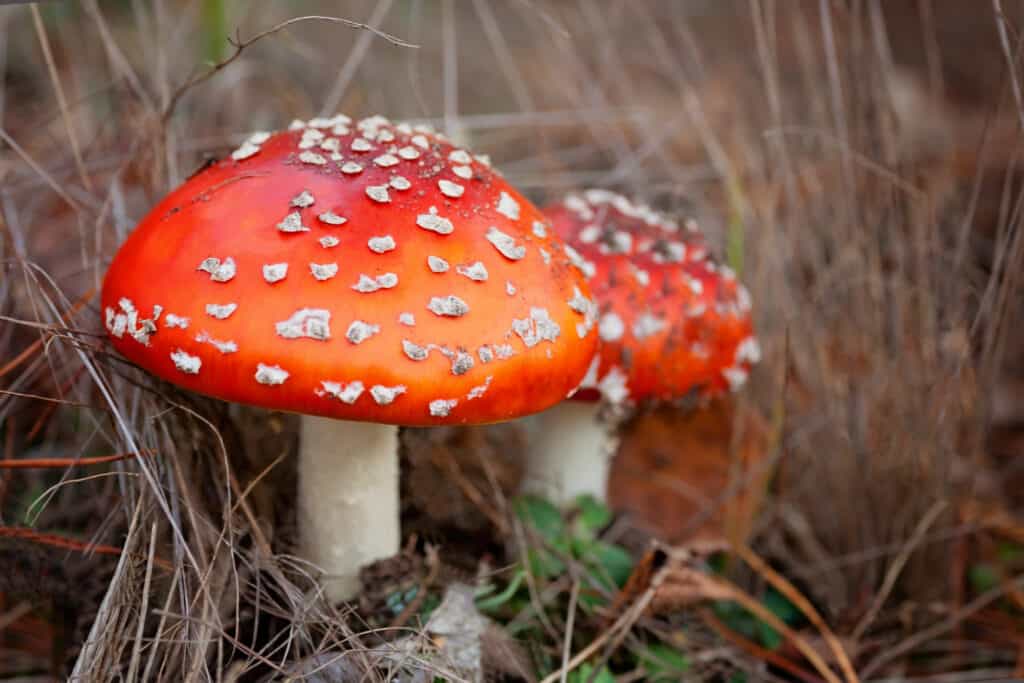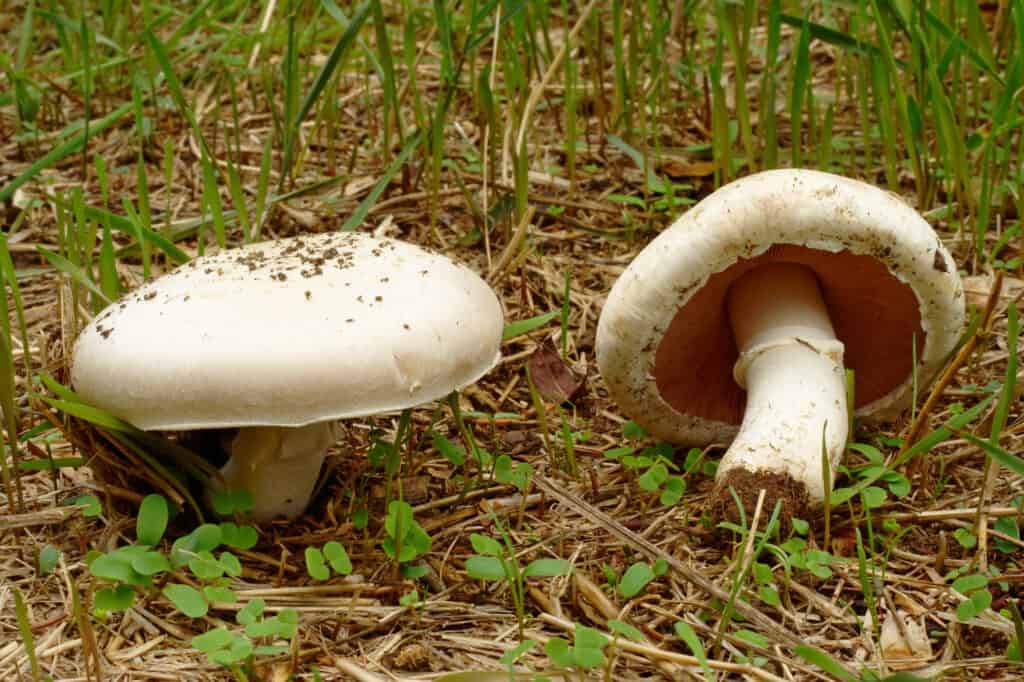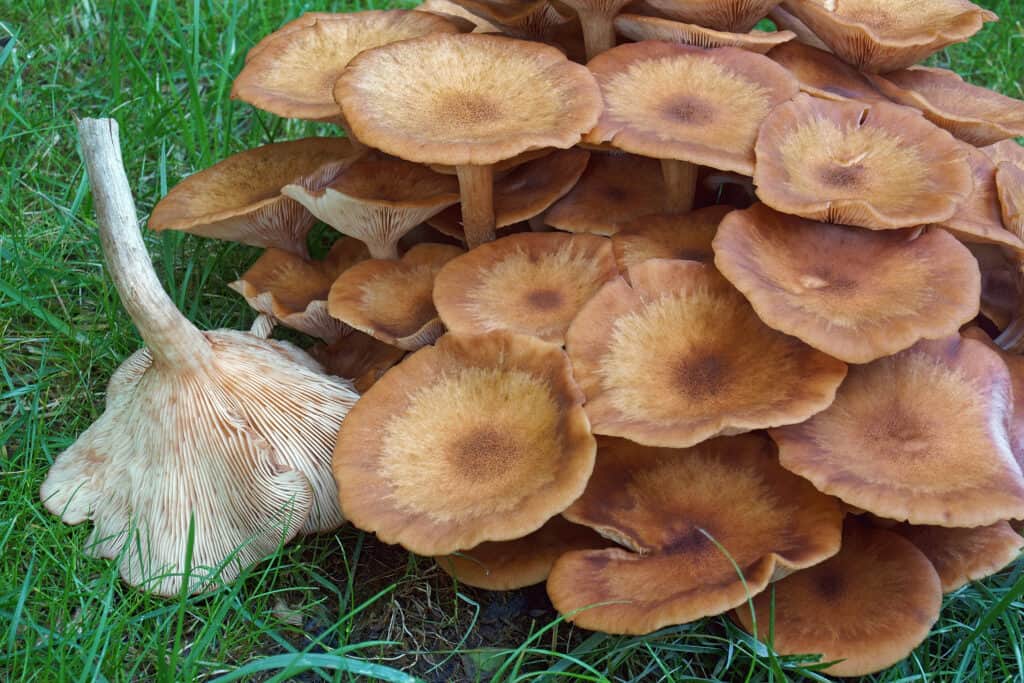The mushroom is a fascinating organism that belongs to the fungi family. Unlike plants and animals, it belongs to an entirely separate kingdom. As a result, it cannot grow its own food like plants or hunt for food like most other animals. Because mushrooms can grow and spread for miles beneath the ground in search of food, it makes them an incredibly fascinating species. Want to learn what exactly this amazing species eats? What do mushrooms eat? Let’s find out!
What Is A Mushroom?

Mushrooms contain a high amount of vitamin D.
©iStock.com/aletheia97
Let’s start by defining what a mushroom is. The uniqueness of mushrooms lies in the fact that they are not a kind of plant or animal, nor are they a kind of bacteria. In the past, scientists believed fungi were part of the plant kingdom because of their similar appearances, cell walls, and the fact that they cannot move around. However, a mushroom is actually the fleshy fruiting body produced by an underground fungus.
A fungus is not considered a plant at this time. Animals, plants, and bacteria differ biologically from these creatures. The way in which mushrooms get their food is one of the most important differences between them and plants. Plants use photosynthesis to produce food. However, in fungi, organic matter is absorbed.
Mushrooms are also extremely popular as a food source for humans. We have eaten them since the beginning of time. Mushrooms were even believed to provide soldiers with strength during battle by the ancient Greeks. A study published in Nutrition Journal found that mushroom consumption was linked with a lower overall mortality rate.
After learning what a mushroom is, let’s find out what mushrooms eat.
What Do Mushrooms Eat?

Over 50 types of mushrooms are capable of digesting and breaking down plastic.
©iStock.com/fedsax
A mushroom eats organic matter in order to survive. The primary source of nutrition for most fungi is the remains of dead organisms, such as animals, bugs, and plant material. As opposed to plants, mushrooms do not contain chlorophyll. This means that the sun does not provide them with sufficient energy to produce their own food. Instead, generally speaking, mushrooms are classified as saprophytes. Therefore, they obtain their nutrition from digesting the organic matter that isn’t alive. The bodies of mushrooms store nutrients and other essential compounds. Once they have enough of these compounds, they start to flower and produce more mushrooms.
Having learned what mushrooms eat, let’s examine how they break down food differently.
How Each Group Of Mushrooms Breaks Down Food
Mushrooms are not restricted as far as what organic material they consume. So they will eat anything that contains the nutrients they need to grow. However, there’s a difference between their food and how all mushrooms extract it. Let’s take a look at the most common groups of mushrooms and how they obtain their food.
Saprophytes
The mushrooms and toadstools that thrive on decaying organic matter are called saprotrophs. Animals and plants are both consumed by them, as well as wood and plants. In the ecosystem, they break down dead organic matter, which is an important part of the decomposition process. By recycling organic matter, they make compost that’s good for the soil and trees. It so happens that saprophytes are some of the most common mushrooms. These mushrooms include Reishi, Cremini, Shiitake, Oyster, Morel, Turkey Tail, Button, and Chestnut.
Mycorrhizae
There is a mutually beneficial relationship between plants and mycorrhizal mushrooms. As a result of their underground network of mycelium, they can interact with the roots of plants through this network. The mycelia of some mycorrhizal mushrooms penetrate plant roots. In other cases, mycelia surround the roots. As a result of the fungi, the root of the plant is extended. The roots are then supplied with additional nutrients and moisture. Through the processes of photosynthesis, trees and plants exchange simple sugars produced by their metabolism with the fungi.
Parasitic
Mushrooms that feed on animals, trees, and other living organisms are called parasitic mushrooms. In contrast to mycorrhizal mushrooms, they feed on the host without giving anything back. Throughout the environment, these parasitic fungi lurk everywhere living organisms and plants exist. In addition, they don’t just attack plants and trees. A caterpillar fungus (Cordyceps sinesis) is one example of a parasitic mushroom that uses insects as hosts.
How Frequently Do Mushrooms Eat?

Under the ground, fungi are able to grow for miles in search of food.
©iStock.com/nickkurzenko
There is no end to the appetite of mushrooms. The stomach is a vital part of animals’ and humans’ lives, as it assists them in detecting when to eat. Mushrooms, however, don’t have this kind of system triggering their hunger cues. In contrast, as long as they remain active, they will constantly eat. Due to the fact that mushrooms don’t eat like animals or humans, it means that they have an unlimited ability to spread when there is plenty of food available.
In the cold months, fungal spores become dormant. This means that they eat little to nothing until the weather warms up. However, a few mushroom species thrive under extreme conditions and can eat year-round. In comparison to us humans, mushrooms can eat and grow forever.
Can All Mushrooms Be Considered Vegan?
Can mushrooms be considered vegan since they feed on organic matter that is not alive? Is it true that all mushrooms are vegan? The answer is no, not all mushrooms are vegan. There are many types of mushrooms, but the majority of them only feed on plants and dead matter. On the other hand, there is a mushroom that eats other living organisms in order to survive.
During the 1980s, scientists discovered that oyster mushrooms are actually surprisingly carnivores. They happen to eat tiny roundworms. So how do they accomplish this? In order to attack, these mushrooms paralyze and then kill their prey through this form of paralysis. After that, its filaments absorb nutrients from the nutrient source. As far as we know, it is the only mushroom that is classified as carnivorous.
The photo featured at the top of this post is © iStock.com/Dan Fog Madsen
The information presented on or through the Website is made available solely for general informational purposes. We do not warrant the accuracy, completeness, or usefulness of this information. Any reliance you place on such information is strictly at your own risk. We disclaim all liability and responsibility arising from any reliance placed on such materials by you or any other visitor to the Website, or by anyone who may be informed of any of its contents. None of the statements or claims on the Website should be taken as medical advice, health advice, or as confirmation that a plant, fungus, or other item is safe for consumption or will provide any health benefits. Anyone considering the health benefits of particular plant, fungus, or other item should first consult with a doctor or other medical professional. The statements made within this Website have not been evaluated by the Food and Drug Administration. These statements are not intended to diagnose, treat, cure or prevent any disease.
Thank you for reading! Have some feedback for us? Contact the AZ Animals editorial team.







